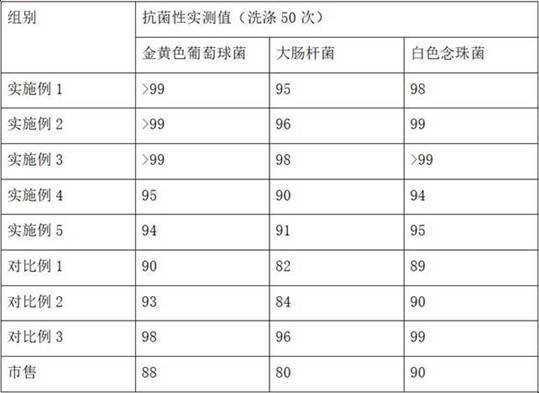Environment-friendly anti-mite non-woven fabric and preparation method thereof
An anti-mite and environmental protection technology, applied in the manufacture of rayon, dry solid materials, textiles and papermaking, etc., can solve the problems of poor anti-mite effect, difficult operation, complex structure, etc., to achieve excellent moisture absorption and ventilation performance, kill Powerful, easily degradable effect
- Summary
- Abstract
- Description
- Claims
- Application Information
AI Technical Summary
Problems solved by technology
Method used
Image
Examples
Embodiment 1
[0033] This embodiment provides a preparation method of an environmentally friendly anti-mite non-woven fabric, specifically as follows:
[0034] (1) Preparation of immobilized anti-mite agent:
[0035] S1. 10g chitosan is dissolved in the acetic acid solution of 1wt%, makes the chitosan solution that chitosan massfraction is 5wt%;
[0036] S2. Dissolving 2g of Asiatic acid in ethanol to make an Asiatic acid solution with a mass fraction of Asiatic acid of 1wt%;
[0037] S3. Dissolving 0.25g of the anti-mite agent in ethanol to make an anti-mite agent solution with a mass fraction of 0.5wt% of the anti-mite agent; the anti-mite agent is a mixture of borneol and eucalyptus oil, and the mass ratio is 3:2;
[0038] S4. Mix the chitosan solution and the asiatic acid solution, stir for 10 minutes, add the anti-mite agent solution, heat up to 50°C, continue stirring for 5 minutes, add genipin at a ratio of 0.5wt% to the final concentration, and continue stirring the reaction After...
Embodiment 2
[0045] This embodiment provides a preparation method of an environmentally friendly anti-mite non-woven fabric, specifically as follows:
[0046] (1) Preparation of immobilized anti-mite agent:
[0047] S1. 10g chitosan is dissolved in the acetic acid solution of 5wt%, makes the chitosan solution that chitosan massfraction is 10wt%;
[0048] S2. Dissolving 3g Asiatic acid in ethanol to make an Asiatic acid solution with a mass fraction of Asiatic acid of 3wt%;
[0049] S3. Dissolving 0.25-0.6g of the anti-mite agent in ethanol to prepare an anti-mite agent solution with a mass fraction of the anti-mite agent of 2.5wt%; the anti-mite agent is a mixture of borneol and eucalyptus oil, and the mass ratio is 7:2;
[0050] S4. Mix the chitosan solution and the asiatic acid solution, stir for 15 minutes, add the anti-mite agent solution, raise the temperature to 70°C, continue stirring for 10 minutes, add genipin at a ratio of 1 wt% final concentration, and continue stirring for 4 h...
Embodiment 3
[0057] This embodiment provides a preparation method of an environmentally friendly anti-mite non-woven fabric, specifically as follows:
[0058] (1) Preparation of immobilized anti-mite agent:
[0059] S1. 10g chitosan is dissolved in the acetic acid solution of 3wt%, makes the chitosan solution that chitosan massfraction is 7wt%;
[0060] S2. Dissolving 2g Asiatic acid in ethanol to make an Asiatic acid solution with a mass fraction of Asiatic acid of 2wt%;
[0061] S3. Dissolving 0.4g of the anti-mite agent in ethanol to make an anti-mite agent solution with a mass fraction of 1.5wt% of the anti-mite agent; the anti-mite agent is a mixture of borneol and eucalyptus oil, and the mass ratio is 5:2;
[0062] S4. Mix the chitosan solution and the asiatic acid solution, stir for 12 minutes, add the anti-mite agent solution, heat up to 60°C, continue stirring for 7 minutes, add genipin at a ratio of 0.7wt% to the final concentration, and continue stirring the reaction After 3 h...
PUM
 Login to View More
Login to View More Abstract
Description
Claims
Application Information
 Login to View More
Login to View More - R&D
- Intellectual Property
- Life Sciences
- Materials
- Tech Scout
- Unparalleled Data Quality
- Higher Quality Content
- 60% Fewer Hallucinations
Browse by: Latest US Patents, China's latest patents, Technical Efficacy Thesaurus, Application Domain, Technology Topic, Popular Technical Reports.
© 2025 PatSnap. All rights reserved.Legal|Privacy policy|Modern Slavery Act Transparency Statement|Sitemap|About US| Contact US: help@patsnap.com


